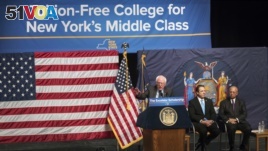14 January, 2017
Many people believe a college education can help any hard working person.
But not everyone is able to attend a college or university. One common barrier is money.
The College Board collects information about colleges and universities across the United States. The organization recently investigated how much it costs Americans to attend a publicly-supported, four-year college in their home state. It found that the average cost for a single student for the 2016-2017 school year is $20,090.
Yet the U.S. higher education system does have other choices. There are two-year community colleges and private four-year universities. Also, students must consider what financial aid can do for them.
For example, after including federal financial aid, the College Board found that the average yearly cost of a four-year public college is $14,210.
However, this assistance still is not enough for some. The American Council on Education (ACE) studies issues related to higher education. A 2015 ACE report used Department of Commerce information to show a decrease in the number of low income students enrolling in college. These men and women have little money available to pay college costs or come from poor families.
The report showed the percentage of American college students considered to be low income went from 55.9 in 2008 to 45.5 in 2013. Yet the ACE reported that spending on all forms of financial aid increased by about $41 billion during that time.

The first in his family to attend college, student Michael Kramer poses for a photo at the University of California, Los Angeles campus.
So now, a group of 30 colleges and universities are taking action. They have all agreed to be part of the American Talent Initiative (ATI). Launched in December, the ATI is a project from a non-profit leadership organization called the Aspen Institute. It also receives support from the higher education research group Ithaka S+R.
Their goal? To increase the total number of low-income men and women studying at these 30 schools to 480,000 by the year 2025.
Josh Wyner is executive director of the Aspen Institute's College Excellence Program. He says one of the reasons this goal is so important is because of the value diversity adds to education. Students from different races and cultures help each other see and understand the world differently, he says. But students from different income backgrounds also have knowledge to share.
And, Wyner notes, ensuring equal chances for everyone is an important part of the American identity.
"While there are schools ... that have done really good work in this area, it remains the case that ... there is still somewhat limited opportunity for students from lower income backgrounds ... So I think ... If we believe in the American dream, which is that hard work should enable you to go as far you talents can take you, we've got to do something about this."
Wyner admits this can be a problem. Any school wishing to join the program must have at least a high graduation rate. Seventy percent of the students must successfully complete their study program. But only 270 of the thousands of U.S. colleges and universities meet this requirement. And the 30 schools currently involved are all different. Some are large, public research colleges. Others are small private universities.
The problem also has several causes, Wyner adds. For example, one reason there are so few low-income students in college is a lack of recruiting. Wyner says schools not only need to find better ways of finding low and middle-income students with the ability to succeed. They also need to be better about letting these students know what financial aid is available.
Many of these students do not think any top college would want them to attend, let alone help them pay the cost, Wyner says.
However, simply providing financial aid is not as simple a solution as it might appear. While the largest amount of aid comes from the government, schools also provide their own.
Some of the aid schools provide comes from tuition dollars taken from students who have enough money to pay the full price. Financial help can also come from a college or university's endowment. This is the money, shares of stock and other financial assets the school receives from donors. The money and other assets are then invested in the hope they will support the school for many years.
Governments do not tax endowments, and the school invests the money to make it last a long time. Most schools only spend small amounts from their endowments each year, hoping not to spend more than the return on their investments.

Senator Bernie Sanders, left, is joined by New York Governor Andrew Cuomo, center, and Chairperson of the Board of Trustees of The City University of New York William C. Thompson, as he speaks about a proposal for free tuition at state colleges.
But a 2016 report from the research group Education Trust argues some colleges and universities have more than enough money to share. Andrew Nichols is director of higher education research for the group. He also helped write the report. It found that 138 U.S. colleges each had an endowment worth over $500 million. Also, the cost of about 4 out of every 5 of these schools is more than 60 percent of the average, yearly family income of low-income students.
Nichols argues that by increasing endowment spending, even in small amounts, large endowment schools could give more aid. Yet they often reject increased spending, he says, because a large endowment is a quality that makes them more desirable.
"I think the resistance really comes from a place of wanting to amass a great amount of wealth so that you can essentially ... talk about how much endowment funds you have ... And so by ... continuing to amass more and more money, you, in some ways, come across as a more prestigious institution."
But Liz Clark says a school cannot spend its endowment money any way it likes. Clark is with the National Association of College and University Business Officers. She notes that donors often place legal restrictions on how money they leave to the endowment is spent.
"So in some cases donors may have restricted funds specifically to help low-income students. And in other cases, donors may have said, ‘I'd like my funds to be used to help support the library or, perhaps, the music department.' And while it is extremely important for colleges and universities to build a ... diverse student body ... they need to have the faculty, the resources, and the educational offerings that make those institutions great. And it takes dollars to help make that happen."
Clark adds if schools give out more and more in financial aid each year, they will likely have little or no endowment money to use in the future. This means the school will be in trouble if it has any financial difficulties in the coming years.
However, there is some middle ground on this issue, says Catharine Hill. She served as president of Vassar College for 10 years before she joined Ithaka S+R in 2016. Hill notes the unequal educational experiences young people from different backgrounds have in the United States. A lot of aid is merit-based, meaning it goes to students performing at the highest level. This often goes to wealthier students, as they have had more educational resources.
Wyner, Nichols, and Hill agree that more aid should be need-based, or should simply go to the students with the greatest need. But Hill says even that is a complex solution.
"We want the talented low and middle-income kids, but their families now can't afford to pay nearly as much relative to the high-income kids. And that means we have to allocate more money to need-based financial aid. That means we have less resources to spend on the things that help us attract those high-income kids. So we're operating in a much more complicated environment today than schools were 40 years ago."
Hill offers one possible solution: schools can re-organize their spending. Vassar College did just this in 2007 when it decided to make cuts in repairs on buildings and other services in favor of need-based aid. The school then reported an increase in its number of low-income students by 9 percent in 8 years.
Also, as Andrew Nichols says, schools could ask for less restrictions on donations, as they used to do in the past. Otherwise, he adds, higher education is at risk of becoming another privilege of those with the most money.
I'm Pete Musto.
Pete Musto wrote this story for VOA Learning English. George Grow was the editor.
We want to hear from you. How is financial aid given in your country? Do universities in your country have endowments? How do they manage them? Write to us in the Comments Section or on 51VOA.COM.
_____________________________________________________________
Words in This Story
low income – adj. relating to a person in the U.S. that earns $17,820 or less a year
enroll(ing) – v. to enter someone as a member of or participant in something
diversity – n. the state of having people who are different races or who have different cultures in a group or organization
background(s) – n. the experiences, knowledge and education in a person's past
graduation – n. the act of receiving a diploma or degree from a school, college, or university
recruit(ing) – v. to find people with the qualities that are right, needed, or appropriate for something and get them to join a company, an organization, school or the armed forces
tuition – n. money that is paid to a school for the right to study there
endowment – n. a large amount of money that has been given to a school or hospital, and that is used to pay for its creation and continuing support
amass – v. to gather or collect something, such as a large amount of money, especially for yourself
prestigious – adj. the respect and admiration that someone or something gets for being successful or important
funds – n. available money
faculty – n. the group of teachers in a school or college
relative – adj. compared to someone or something else or to each other
allocate – v. to divide and give out something for a special reason or to particular people or companies
privilege – n. a right or benefit that is given to some people and not to others